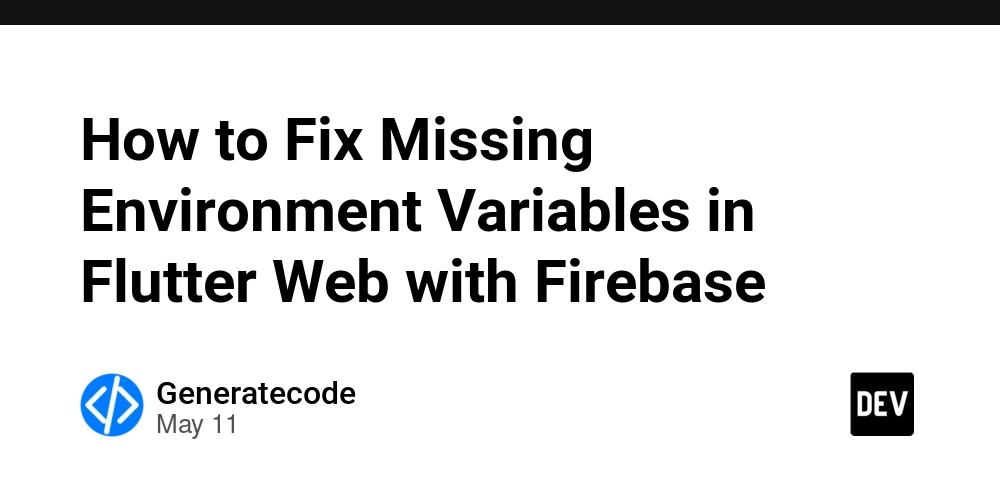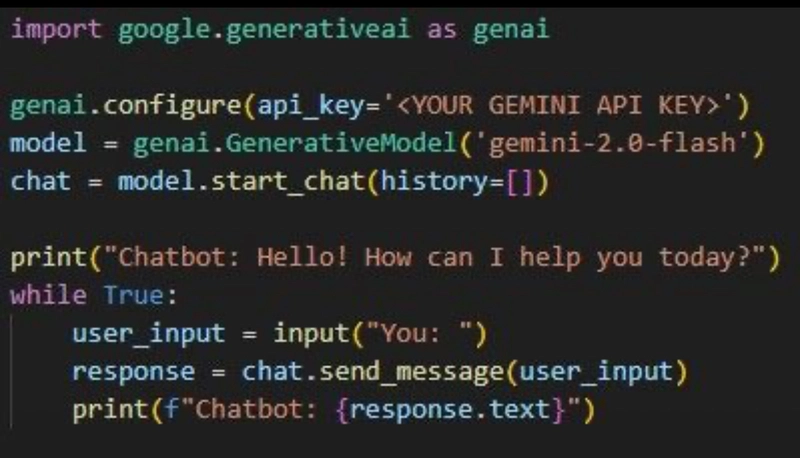How to Fix Missing Environment Variables in Flutter Web with Firebase
When developing Flutter web applications and deploying them on Firebase Hosting, you may encounter the issue of missing environment variables even after following the correct steps for setting them up. In this article, we will explore the reasons behind this problem and provide a clear guide on how to resolve it using the correct Dart and Flutter techniques. Understanding Environment Variables in Flutter Environment variables are crucial for storing sensitive information and settings for your application, such as API keys and configuration settings. When using Flutter with Firebase Hosting, it’s common to define environment variables via a JSON file and set them during the build process. Why Environment Variables Might Be Missing Here are some common reasons you might experience missing environment variables after deployment: Build Configuration: The build might not be configured correctly to read the variables. JSON File Issue: There could be issues with the JSON file itself, like a typo. Firebase Delay: Sometimes, Firebase might take longer than expected for the changes to reflect. To solve these issues, you'll need to carefully follow specific steps during your build process. Let’s dive into those. Step-by-Step Solution to Access Environment Variables in Production Step 1: Verify your Json File Before proceeding, ensure that your JSON file containing the environment variables is formatted correctly. Run the following command to check its contents: cat assets/env_folder/env.prod.json Make sure that the key-value pairs are correct and free of syntax errors. Step 2: Clean the Build Artifacts Sometimes, the .dart_tool and build directories can contain outdated information. Run the following command to remove them: rm -rf .dart_tool build This step clears up any cached data or previous builds that may interfere with accessing variables. Step 3: Build the Application Correctly Next, execute the build command to compile your Flutter web application with the specified environment variables from the JSON file: flutter build web --release --dart-define-from-file=assets/env_folder/env.prod.json -v The -v flag enables verbose output, allowing you to see if the environment variables are correctly being read during the build process. Watch the logs for the proper loading of your keys. Step 4: Deploy Your Application on Firebase Once the build is complete, deploy the application to Firebase Hosting using the command: firebase deploy After deploying, make sure you wait for about 5-10 minutes, as Firebase can take time to propagate new changes across its servers. Step 5: Access Environment Variables in Dart Code To use the loaded environment variable within your Dart code, you will need to define it like so: String get myKey { const key = String.fromEnvironment('ENV_KEY'); return key; } Ensure that you replace 'ENV_KEY' with the actual key defined in your JSON file. Finally, check if the environment variable is being loaded successfully: if (EnvManager.shared.myKey.isEmpty) { print('Missing Env Values'); } else { print('Env. initialized'); } If you see Missing Env Values, go back and double-check the previous steps. It's essential to ensure that the key names match exactly between your code and the JSON. Frequently Asked Questions What is dart-define-from-file? The --dart-define-from-file flag allows you to pass a file containing key-value pairs as environment variables during the Flutter build process. This can be particularly handy for managing configurations in different environments. Can I store sensitive data in the JSON file? It’s not recommended to store highly sensitive information, like passwords or API keys, in plain text within a JSON file, especially if it’s going to be deployed in a web application. Consider using more secure approaches like Environment Secrets on your CI/CD tool. Why are my environment variables still missing after following the steps? If you still encounter issues despite following these steps, ensure the format of your JSON file is correct and there are no typos. Additionally, it may help to double-check Firebase deployments and try redeploying if necessary. Now you can effectively troubleshoot the missing environment variables in your Flutter web application when deploying to Firebase. Happy coding!

When developing Flutter web applications and deploying them on Firebase Hosting, you may encounter the issue of missing environment variables even after following the correct steps for setting them up. In this article, we will explore the reasons behind this problem and provide a clear guide on how to resolve it using the correct Dart and Flutter techniques.
Understanding Environment Variables in Flutter
Environment variables are crucial for storing sensitive information and settings for your application, such as API keys and configuration settings. When using Flutter with Firebase Hosting, it’s common to define environment variables via a JSON file and set them during the build process.
Why Environment Variables Might Be Missing
Here are some common reasons you might experience missing environment variables after deployment:
- Build Configuration: The build might not be configured correctly to read the variables.
- JSON File Issue: There could be issues with the JSON file itself, like a typo.
- Firebase Delay: Sometimes, Firebase might take longer than expected for the changes to reflect.
To solve these issues, you'll need to carefully follow specific steps during your build process. Let’s dive into those.
Step-by-Step Solution to Access Environment Variables in Production
Step 1: Verify your Json File
Before proceeding, ensure that your JSON file containing the environment variables is formatted correctly. Run the following command to check its contents:
cat assets/env_folder/env.prod.json
Make sure that the key-value pairs are correct and free of syntax errors.
Step 2: Clean the Build Artifacts
Sometimes, the .dart_tool and build directories can contain outdated information. Run the following command to remove them:
rm -rf .dart_tool build
This step clears up any cached data or previous builds that may interfere with accessing variables.
Step 3: Build the Application Correctly
Next, execute the build command to compile your Flutter web application with the specified environment variables from the JSON file:
flutter build web --release --dart-define-from-file=assets/env_folder/env.prod.json -v
The -v flag enables verbose output, allowing you to see if the environment variables are correctly being read during the build process. Watch the logs for the proper loading of your keys.
Step 4: Deploy Your Application on Firebase
Once the build is complete, deploy the application to Firebase Hosting using the command:
firebase deploy
After deploying, make sure you wait for about 5-10 minutes, as Firebase can take time to propagate new changes across its servers.
Step 5: Access Environment Variables in Dart Code
To use the loaded environment variable within your Dart code, you will need to define it like so:
String get myKey {
const key = String.fromEnvironment('ENV_KEY');
return key;
}
Ensure that you replace 'ENV_KEY' with the actual key defined in your JSON file.
Finally, check if the environment variable is being loaded successfully:
if (EnvManager.shared.myKey.isEmpty) {
print('Missing Env Values');
} else {
print('Env. initialized');
}
If you see Missing Env Values, go back and double-check the previous steps. It's essential to ensure that the key names match exactly between your code and the JSON.
Frequently Asked Questions
What is dart-define-from-file?
The --dart-define-from-file flag allows you to pass a file containing key-value pairs as environment variables during the Flutter build process. This can be particularly handy for managing configurations in different environments.
Can I store sensitive data in the JSON file?
It’s not recommended to store highly sensitive information, like passwords or API keys, in plain text within a JSON file, especially if it’s going to be deployed in a web application. Consider using more secure approaches like Environment Secrets on your CI/CD tool.
Why are my environment variables still missing after following the steps?
If you still encounter issues despite following these steps, ensure the format of your JSON file is correct and there are no typos. Additionally, it may help to double-check Firebase deployments and try redeploying if necessary.
Now you can effectively troubleshoot the missing environment variables in your Flutter web application when deploying to Firebase. Happy coding!











































































































































































![[The AI Show Episode 156]: AI Answers - Data Privacy, AI Roadmaps, Regulated Industries, Selling AI to the C-Suite & Change Management](https://www.marketingaiinstitute.com/hubfs/ep%20156%20cover.png)
![[The AI Show Episode 155]: The New Jobs AI Will Create, Amazon CEO: AI Will Cut Jobs, Your Brain on ChatGPT, Possible OpenAI-Microsoft Breakup & Veo 3 IP Issues](https://www.marketingaiinstitute.com/hubfs/ep%20155%20cover.png)




































































































































































































































































_incamerastock_Alamy.jpg?width=1280&auto=webp&quality=80&disable=upscale#)
_Brain_light_Alamy.jpg?width=1280&auto=webp&quality=80&disable=upscale#)



























































































![Nothing Phone (3) has a 50MP ‘periscope’ telephoto lens – here are the first samples [Gallery]](https://i0.wp.com/9to5google.com/wp-content/uploads/sites/4/2025/06/nothing-phone-3-telephoto.jpg?resize=1200%2C628&quality=82&strip=all&ssl=1)



























































































